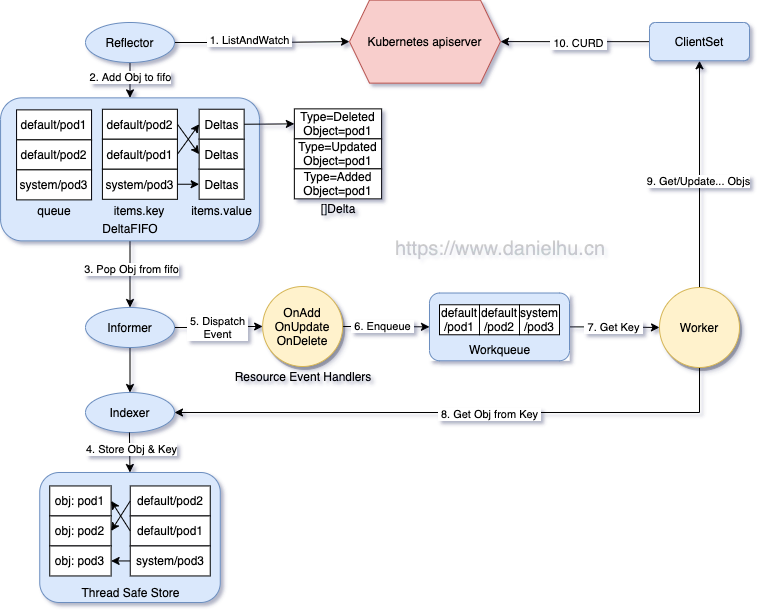概述Queue接口和结构体setAdd()Get()Done()DelayingQueue接口和结构体waitForNewDelayingQueuewaitingLoop()AddAfter()RateLimitingQueue接口和结构体RateLimiterBucketRateLimiterItemExponentialFailureRateLimiterItemFastSlowRateLimiterMaxOfRateLimiterWithMaxWaitRateLimiter限速队列的实现
概述
源码版本信息
- Project: kubernetes
- Branch: master
- Last commit id: d25d741c
- Date: 2021-09-26
我们在《Kubernetes client-go 源码分析 - 开篇》里提到了自定义控制器涉及到的 client-go 组件整体工作流程,大致如下图:

今天我们来详细研究下 workqueue 相关代码。client-go 的 util/workqueue 包里主要有三个队列,分别是普通队列,延时队列,限速队列,后一个队列以前一个队列的实现为基础,层层添加新功能,我们按照 Queue、DelayingQueue、RateLimitingQueue 的顺序层层拨开来看限速队列是如何实现的。
Queue
接口和结构体
先看接口定义:
- k8s.io/client-go/util/workqueue/queue.go:26
1type Interface interface {
2 Add(item interface{}) // 添加一个元素
3 Len() int // 元素个数
4 Get() (item interface{}, shutdown bool) // 获取一个元素,第二个返回值和 channel 类似,标记队列是否关闭了
5 Done(item interface{}) // 标记一个元素已经处理完
6 ShutDown() // 关闭队列
7 ShuttingDown() bool // 是否正在关闭
8}
这个基础的队列接口定义很清晰,我们继续来看其实现的类型:
1type Type struct {
2 queue []t // 定义元素的处理顺序,里面所有元素都应该在 dirty set 中有,而不能出现在 processing set 中
3 dirty set // 标记所有需要被处理的元素
4 processing set // 当前正在被处理的元素,当处理完后需要检查该元素是否在 dirty set 中,如果有则添加到 queue 里
5
6 cond *sync.Cond // 条件锁
7 shuttingDown bool // 是否正在关闭
8 metrics queueMetrics
9 unfinishedWorkUpdatePeriod time.Duration
10 clock clock.Clock
11}
这个 Queue 的工作逻辑大致是这样,里面的三个属性 queue、dirty、processing 都保存 items,但是含义有所不同:
- queue:这是一个 []t 类型,也就是一个切片,因为其有序,所以这里当作一个列表来存储 item 的处理顺序。
- dirty:这是一个 set 类型,也就是一个集合,这个集合存储的是所有需要处理的 item,这些 item 也会保存在 queue 中,但是 set 里是无需的,set 的特性是唯一。
- processing:这也是一个 set,存放的是当前正在处理的 item,也就是说这个 item 来自 queue 出队的元素,同时这个元素会被从 dirty 中删除。
下面分别介绍 set 类型和 Queue 接口的集合核心方法的实现。
set
上面提到的 dirty 和 processing 字段都是 set 类型,set 相关定义如下:
1type empty struct{}
2type t interface{}
3type set map[t]empty
4
5func (s set) has(item t) bool {
6 _, exists := s[item]
7 return exists
8}
9
10func (s set) insert(item t) {
11 s[item] = empty{}
12}
13
14func (s set) delete(item t) {
15 delete(s, item)
16}
set 是一个空接口到空结构体的 map,也就是实现了一个集合的功能,集合元素是 interface{} 类型,也就是可以存储任意类型。而 map 的 value 是 struct{} 类型,也就是空。这里利用 map 的 key 唯一的特性实现了一个集合类型,附带三个方法 has()、insert()、delete() 来实现集合相关操作。
Add()
Add() 方法用于标记一个 item 需要被处理,代码如下:
1func (q *Type) Add(item interface{}) {
2 q.cond.L.Lock()
3 defer q.cond.L.Unlock()
4 if q.shuttingDown { // 如果 queue 正在被关闭,则返回
5 return
6 }
7 if q.dirty.has(item) { // 如果 dirty set 中已经有了该 item,则返回
8 return
9 }
10
11 q.metrics.add(item)
12
13 q.dirty.insert(item) // 添加到 dirty set 中
14 if q.processing.has(item) { // 如果正在被处理,则返回
15 return
16 }
17
18 q.queue = append(q.queue, item) // 如果没有正在处理,则加到 q.queue 中
19 q.cond.Signal() // 通知某个 getter 有新 item 到来
20}
Get()
1func (q *Type) Get() (item interface{}, shutdown bool) {
2 q.cond.L.Lock()
3 defer q.cond.L.Unlock()
4 for len(q.queue) == 0 && !q.shuttingDown { // 如果 q.queue 为空,并且没有正在关闭,则等待下一个 item 的到来
5 q.cond.Wait()
6 }
7 if len(q.queue) == 0 { // 这时候如果 q.queue 长度还是 0,说明 q.shuttingDown 为 true,所以直接返回
8 return nil, true
9 }
10
11 item, q.queue = q.queue[0], q.queue[1:] // 获取 q.queue 第一个元素,同时更新 q.queue
12
13 q.metrics.get(item)
14
15 q.processing.insert(item) // 刚才获取到的 q.queue 第一个元素放到 processing set 中
16 q.dirty.delete(item) // dirty set 中删除该元素
17
18 return item, false // 返回 item
19}
Done()
1func (q *Type) Done(item interface{}) {
2 q.cond.L.Lock()
3 defer q.cond.L.Unlock()
4
5 q.metrics.done(item)
6
7 q.processing.delete(item) // processing set 中删除该 item
8 if q.dirty.has(item) { // 如果 dirty 中还有,说明还需要再次处理,放到 q.queue 中
9 q.queue = append(q.queue, item)
10 q.cond.Signal() // 通知某个 getter 有新的 item
11 }
12}
DelayingQueue
接口和结构体
还是先看接口定义:
- k8s.io/client-go/util/workqueue/delaying_queue.go:30
1type DelayingInterface interface {
2 Interface
3 // AddAfter adds an item to the workqueue after the indicated duration has passed
4 AddAfter(item interface{}, duration time.Duration)
5}
相比 Queue 这里只是多了一个 AddAfter(item interface{}, duration time.Duration) 方法,望文生义,也就是延时添加 item。
结构体定义:
1type delayingType struct {
2 Interface // 用来嵌套普通 Queue
3 clock clock.Clock // 计时器
4 stopCh chan struct{}
5 stopOnce sync.Once // 用来确保 ShutDown() 方法只执行一次
6 heartbeat clock.Ticker // 默认10s的心跳,后面用在一个大循环里,避免没有新 item 时一直卡住
7 waitingForAddCh chan *waitFor // 传递 waitFor 的 channel,默认大小 1000
8 metrics retryMetrics
9}
对于延时队列,我们关注的入口方法肯定就是新增的 AddAfter() 了,看这个方法的具体的逻辑前我们先看下上面提到的 waitFor 类型。
waitFor
先看下 waitFor 结构定义,代码如下:
1type waitFor struct { data t // 准备添加到队列中的数据 readyAt time.Time // 应该被加入队列的时间 index int // 在 heap 中的索引}
然后可以注意到有这样一行代码:
1type waitForPriorityQueue []*waitFor
这里定义了一个 waitFor 的优先级队列,用最小堆的方式来实现,这个类型实现了 heap.Interface 接口,我们具体看下源码:
1// 添加一个 item 到队列中func (pq *waitForPriorityQueue) Push(x interface{}) { n := len(*pq) item := x.(*waitFor) item.index = n *pq = append(*pq, item) // 添加到队列的尾巴}// 从队列尾巴移除一个 itemfunc (pq *waitForPriorityQueue) Pop() interface{} { n := len(*pq) item := (*pq)[n-1] item.index = -1 *pq = (*pq)[0:(n - 1)] return item}// 获取队列第一个 itemfunc (pq waitForPriorityQueue) Peek() interface{} { return pq[0]}
NewDelayingQueue
接着看一下 DelayingQueue 相关的几个 New 函数,理解了这里的逻辑,才能继续往后面分析 AddAfter() 方法。
1// 这里可以传递一个名字func NewNamedDelayingQueue(name string) DelayingInterface { return NewDelayingQueueWithCustomClock(clock.RealClock{}, name)}// 上面一个函数只是调用当前函数,附带一个名字,这里加了一个指定 clock 的能力func NewDelayingQueueWithCustomClock(clock clock.Clock, name string) DelayingInterface { return newDelayingQueue(clock, NewNamed(name), name) // 注意这里的 NewNamed() 函数}func newDelayingQueue(clock clock.Clock, q Interface, name string) *delayingType { ret := &delayingType{ Interface: q, clock: clock, heartbeat: clock.NewTicker(maxWait), // 10s 一次心跳 stopCh: make(chan struct{}), waitingForAddCh: make(chan *waitFor, 1000), metrics: newRetryMetrics(name), } go ret.waitingLoop() // 留意这里的函数调用 return ret}
上面涉及到两个细节:
NewNamed(name)go ret.waitingLoop()
NewNamed() 函数用于创建一个前面提到的 Queue 的对应类型 Type 对象,这个值被传递给了 newDelayingQueue() 函数,进而赋值给了 delayingType{} 对象的 Interface 字段,于是后面 delayingType 类型才能直接调用 Type 类型实现的方法。
1func NewNamed(name string) *Type { rc := clock.RealClock{} return newQueue( rc, globalMetricsFactory.newQueueMetrics(name, rc), defaultUnfinishedWorkUpdatePeriod, )}
waitingLoop() 方法逻辑不少,我们单独放到下面一个小节
waitingLoop()
这个方法是实现延时队列的核心逻辑所在,
1func (q *delayingType) waitingLoop() { defer utilruntime.HandleCrash() // 队列里没有 item 时实现等待用的 never := make(<-chan time.Time) var nextReadyAtTimer clock.Timer // 构造一个有序队列 waitingForQueue := &waitForPriorityQueue{} heap.Init(waitingForQueue) // 这一行其实是多余的,等下提个 pr 给它删掉 // 这个 map 用来处理重复添加逻辑的,下面会讲到 waitingEntryByData := map[t]*waitFor{} // 无限循环 for { // 这个地方 Interface 是多余的,等下也提个 pr 把它删掉吧 if q.Interface.ShuttingDown() { return } now := q.clock.Now() // 队列里有 item 就开始循环 for waitingForQueue.Len() > 0 { // 获取第一个 item entry := waitingForQueue.Peek().(*waitFor) // 时间还没到,先不处理 if entry.readyAt.After(now) { break } // 时间到了,pop 出第一个元素;注意 waitingForQueue.Pop() 是最后一个 item,heap.Pop() 是第一个元素 entry = heap.Pop(waitingForQueue).(*waitFor) // 将数据加到延时队列里 q.Add(entry.data) // map 里删除已经加到延时队列的 item delete(waitingEntryByData, entry.data) } // 如果队列中有 item,就用第一个 item 的等待时间初始化计时器,如果为空则一直等待 nextReadyAt := never if waitingForQueue.Len() > 0 { if nextReadyAtTimer != nil { nextReadyAtTimer.Stop() } entry := waitingForQueue.Peek().(*waitFor) nextReadyAtTimer = q.clock.NewTimer(entry.readyAt.Sub(now)) nextReadyAt = nextReadyAtTimer.C() } select { case <-q.stopCh: return case <-q.heartbeat.C(): // 心跳时间是 10s,到了就继续下一轮循环 case <-nextReadyAt: // 第一个 item 的等到时间到了,继续下一轮循环 case waitEntry := <-q.waitingForAddCh: // waitingForAddCh 收到新的 item // 如果时间没到,就加到优先级队列里,如果时间到了,就直接加到延时队列里 if waitEntry.readyAt.After(q.clock.Now()) { insert(waitingForQueue, waitingEntryByData, waitEntry) } else { q.Add(waitEntry.data) } // 下面的逻辑就是将 waitingForAddCh 中的数据处理完 drained := false for !drained { select { case waitEntry := <-q.waitingForAddCh: if waitEntry.readyAt.After(q.clock.Now()) { insert(waitingForQueue, waitingEntryByData, waitEntry) } else { q.Add(waitEntry.data) } default: drained = true } } } }}
上面函数还有一个 insert() 调用,我们再来看一下这个插入逻辑:
1func insert(q *waitForPriorityQueue, knownEntries map[t]*waitFor, entry *waitFor) { // 这里的主要逻辑是看一个 entry 是否存在,如果已经存在,新的 entry 的 ready 时间更短,就更新时间 existing, exists := knownEntries[entry.data] if exists { if existing.readyAt.After(entry.readyAt) { existing.readyAt = entry.readyAt // 如果存在就只更新时间 heap.Fix(q, existing.index) } return } // 如果不存在就丢到 q 里,同时在 map 里记录一下,用于查重 heap.Push(q, entry) knownEntries[entry.data] = entry}
AddAfter()
这个方法的作用是在指定的延时到达之后,在 work queue 中添加一个元素,源码如下:
1func (q *delayingType) AddAfter(item interface{}, duration time.Duration) { if q.ShuttingDown() { // 已经在关闭中就直接返回 return } q.metrics.retry() if duration <= 0 { // 如果时间到了,就直接添加 q.Add(item) return } select { case <-q.stopCh: // 构造 waitFor{},丢到 waitingForAddCh case q.waitingForAddCh <- &waitFor{data: item, readyAt: q.clock.Now().Add(duration)}: }}
RateLimitingQueue
最后一个 workqueue 就是限速队列,我们继续来看。
接口和结构体
先看接口定义
- k8s.io/client-go/util/workqueue/rate_limiting_queue.go:20
1type RateLimitingInterface interface { DelayingInterface // 延时队列里内嵌了普通队列,限速队列里内嵌了延时队列 AddRateLimited(item interface{}) // 限速方式往队列里加入一个元素 Forget(item interface{}) // 标识一个元素结束重试 NumRequeues(item interface{}) int // 标识这个元素被处理里多少次了}
然后看下两个 New 函数
1func NewRateLimitingQueue(rateLimiter RateLimiter) RateLimitingInterface { return &rateLimitingType{ DelayingInterface: NewDelayingQueue(), rateLimiter: rateLimiter, }}func NewNamedRateLimitingQueue(rateLimiter RateLimiter, name string) RateLimitingInterface { return &rateLimitingType{ DelayingInterface: NewNamedDelayingQueue(name), rateLimiter: rateLimiter, }}
这里的区别就是里面的延时队列有没有指定的名字。注意到这里有一个 RateLimiter 类型,后面要详细讲,另外 rateLimitingType 就是上面接口的具体实现类型了。
RateLimiter
RateLimiter 表示一个限速器,我们看下限速器是什么意思。先看接口定义:
k8s.io/client-go/util/workqueue/default_rate_limiters.go:27
1type RateLimiter interface { When(item interface{}) time.Duration // 返回一个 item 需要等待的时常 Forget(item interface{}) // 标识一个元素结束重试 NumRequeues(item interface{}) int // 标识这个元素被处理里多少次了}
这个接口有五个实现,分别叫做:
- BucketRateLimiter
- ItemExponentialFailureRateLimiter
- ItemFastSlowRateLimiter
- MaxOfRateLimiter
- WithMaxWaitRateLimiter
下面分别来看
BucketRateLimiter
这个限速器可说的不多,用了 golang 标准库的 golang.org/x/time/rate.Limiter 实现。BucketRateLimiter 实例化的时候比如传递一个 rate.NewLimiter(rate.Limit(10), 100) 进去,表示令牌桶里最多有 100 个令牌,每秒发放 10 个令牌。
1type BucketRateLimiter struct { *rate.Limiter}var _ RateLimiter = &BucketRateLimiter{}func (r *BucketRateLimiter) When(item interface{}) time.Duration { return r.Limiter.Reserve().Delay() // 过多久后给当前 item 发放一个令牌}func (r *BucketRateLimiter) NumRequeues(item interface{}) int { return 0}func (r *BucketRateLimiter) Forget(item interface{}) {}
ItemExponentialFailureRateLimiter
Exponential 是指数的意思,从这个限速器的名字大概能猜到是失败次数越多,限速越长而且是指数级增长的一种限速器。
结构体定义如下,属性含义基本可以望文生义
1type ItemExponentialFailureRateLimiter struct { failuresLock sync.Mutex failures map[interface{}]int baseDelay time.Duration maxDelay time.Duration}
主要逻辑是 When() 函数是如何实现的
1func (r *ItemExponentialFailureRateLimiter) When(item interface{}) time.Duration { r.failuresLock.Lock() defer r.failuresLock.Unlock() exp := r.failures[item] r.failures[item] = r.failures[item] + 1 // 失败次数加一 // 每调用一次,exp 也就加了1,对应到这里时 2^n 指数爆炸 backoff := float64(r.baseDelay.Nanoseconds()) * math.Pow(2, float64(exp)) if backoff > math.MaxInt64 { // 如果超过了最大整型,就返回最大延时,不然后面时间转换溢出了 return r.maxDelay } calculated := time.Duration(backoff) if calculated > r.maxDelay { // 如果超过最大延时,则返回最大延时 return r.maxDelay } return calculated}
另外两个函数太简单了:
1func (r *ItemExponentialFailureRateLimiter) NumRequeues(item interface{}) int { r.failuresLock.Lock() defer r.failuresLock.Unlock() return r.failures[item]}func (r *ItemExponentialFailureRateLimiter) Forget(item interface{}) { r.failuresLock.Lock() defer r.failuresLock.Unlock() delete(r.failures, item)}
ItemFastSlowRateLimiter
快慢限速器,也就是先快后慢,定义一个阈值,超过了就慢慢重试。先看类型定义:
1type ItemFastSlowRateLimiter struct { failuresLock sync.Mutex failures map[interface{}]int maxFastAttempts int // 快速重试的次数 fastDelay time.Duration // 快重试间隔 slowDelay time.Duration // 慢重试间隔}
同样继续来看具体的方法实现
1func (r *ItemFastSlowRateLimiter) When(item interface{}) time.Duration { r.failuresLock.Lock() defer r.failuresLock.Unlock() r.failures[item] = r.failures[item] + 1 // 标识重试次数 + 1 if r.failures[item] <= r.maxFastAttempts { // 如果快重试次数没有用完,则返回 fastDelay return r.fastDelay } return r.slowDelay // 反之返回 slowDelay}func (r *ItemFastSlowRateLimiter) NumRequeues(item interface{}) int { r.failuresLock.Lock() defer r.failuresLock.Unlock() return r.failures[item]}func (r *ItemFastSlowRateLimiter) Forget(item interface{}) { r.failuresLock.Lock() defer r.failuresLock.Unlock() delete(r.failures, item)}
MaxOfRateLimiter
这个限速器看着有点乐呵人,内部放多个限速器,然后返回限速最狠的一个延时:
1type MaxOfRateLimiter struct { limiters []RateLimiter}func (r *MaxOfRateLimiter) When(item interface{}) time.Duration { ret := time.Duration(0) for _, limiter := range r.limiters { curr := limiter.When(item) if curr > ret { ret = curr } } return ret}
WithMaxWaitRateLimiter
这个限速器也很简单,就是在其他限速器上包装一个最大延迟的属性,如果到了最大延时,则直接返回:
1type WithMaxWaitRateLimiter struct { limiter RateLimiter // 其他限速器 maxDelay time.Duration // 最大延时}func NewWithMaxWaitRateLimiter(limiter RateLimiter, maxDelay time.Duration) RateLimiter { return &WithMaxWaitRateLimiter{limiter: limiter, maxDelay: maxDelay}}func (w WithMaxWaitRateLimiter) When(item interface{}) time.Duration { delay := w.limiter.When(item) if delay > w.maxDelay { return w.maxDelay // 已经超过了最大延时,直接返回最大延时 } return delay}
限速队列的实现
看完了上面的限速器的概念,限速队列的实现就很简单了:
1func (q *rateLimitingType) AddRateLimited(item interface{}) { // 内部存了一个延时队列,通过限速器计算出一个等待时间,然后传给延时队列 q.DelayingInterface.AddAfter(item, q.rateLimiter.When(item))}func (q *rateLimitingType) NumRequeues(item interface{}) int { return q.rateLimiter.NumRequeues(item)}func (q *rateLimitingType) Forget(item interface{}) { q.rateLimiter.Forget(item)}
打完收工。
(转载请保留本文原始链接 https://www.danielhu.cn)
